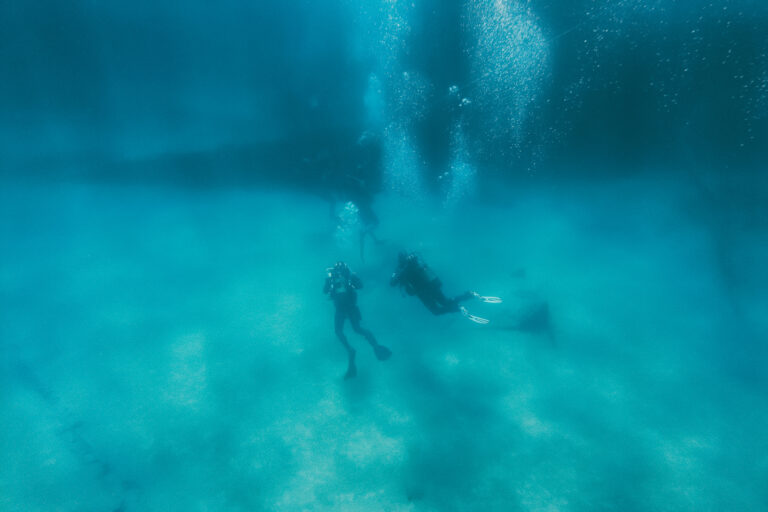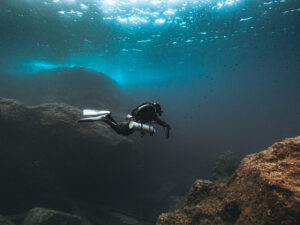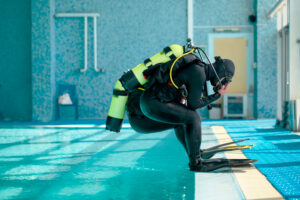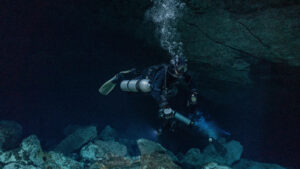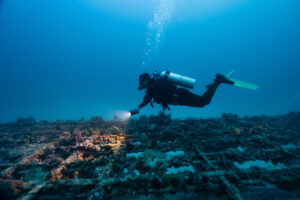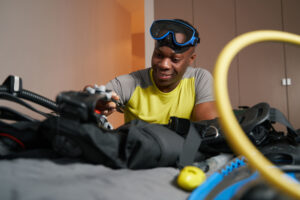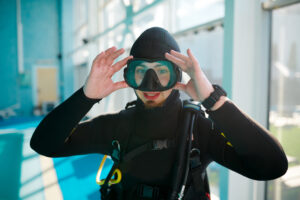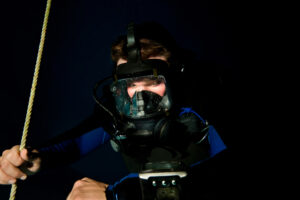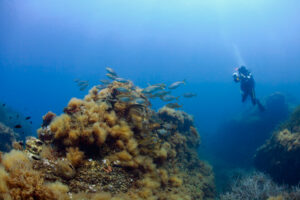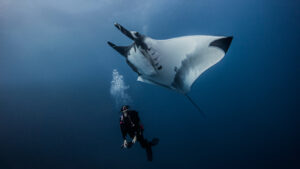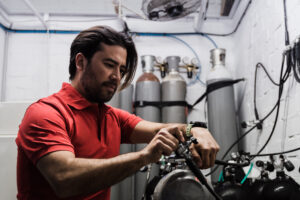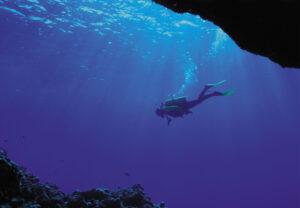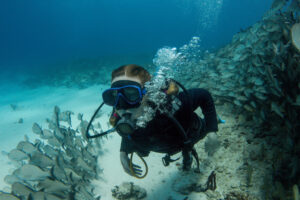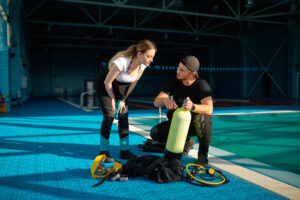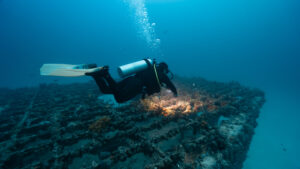What is a Air Compressor?
Diving beneath the ocean’s surface and exploring its hidden marvels is an exhilarating experience, the wonderment of which is enabled by the technologically advanced gear that divers wear. Among the critical components that ensure the safety and capability of these aquatic explorers is the air compressor—a fascinating piece of equipment that is as integral as it is intriguing.
An air compressor, in essence, is a device that pressurizes and compresses air. However, this definition barely scratches the surface of its significance in scuba diving. From filling the scuba tanks to operating the buoyancy control device (BCD), the air compressor’s role is widespread and multifaceted.
The Function and Mechanism of Air Compressors
Purpose of Air Compressors in Scuba Diving
The primary role of an air compressor in scuba diving is to pressurize and fill the scuba tanks or cylinders, which contain the breathing gas for divers. Without the pressure provided by an air compressor, it would be impossible to store the large volume of air required for divers to breathe underwater. This piece of equipment ensures that divers have a constant and sufficient supply of breathable air during their undersea adventures.
Moreover, air compressors are also used in certain diving equipment like buoyancy control devices. They are instrumental in creating the right balance underwater, allowing divers to ascend, descend, or maintain their depth with precision.
Working Principle of Air Compressors
The working principle of an air compressor is based on the physics of gases and pressure. Essentially, the compressor draws in atmospheric air and reduces its volume while simultaneously increasing its pressure. This compressed air can then be stored in a relatively small cylinder—typically made of steel or aluminum—without losing its oxygen content.
The key components of an air compressor include an intake valve, a compressor unit, a compression chamber, and an output valve. The intake valve draws in atmospheric air, which is then compressed by the compressor unit in the compression chamber. The resulting high-pressure air is then expelled through the output valve into the scuba cylinder.
This process, also known as ‘positive displacement’, is achieved through either reciprocating piston technology or rotary screw technology. In both cases, the increase in pressure is a result of reducing the physical space that the air molecules occupy, forcing them to exist in a state of higher energy and pressure.
Types of Air Compressors in Scuba Diving
High-Pressure Air Compressors
High-pressure air (HPA) compressors are widely used in scuba diving. As the name implies, these compressors can generate extremely high pressures, typically around 3000 to 3500 psi. They are able to compress a large volume of air into the small cylinders that divers carry on their backs, making them ideal for scuba applications.
The operational efficiency of HPA compressors is quite remarkable. These devices usually consist of multiple stages—each comprising a piston and cylinder—to progressively compress the air. After each stage, the air is cooled to remove excess heat generated during compression.
High-pressure air compressors can be either electrically powered or gasoline-powered. Electric compressors are often used in dive shops and on dive boats, where electrical power is readily available. In contrast, gasoline-powered compressors are typically used in remote locations where electrical power may not be accessible.
Low-Pressure Air Compressors
While high-pressure air compressors are common in scuba diving, there are also instances where low-pressure compressors come into play. These are often used to inflate buoyancy
control devices and are also a critical part of surface-supplied diving systems. Although they don’t generate the same extreme pressures as HPA compressors, they still play an essential role in divers’ safety and functionality underwater.
Low-pressure air compressors operate on similar principles to high-pressure compressors but are designed to output air at much lower pressures—typically around 150 psi. They are often smaller, lighter, and simpler in design compared to their high-pressure counterparts.
The Importance of Air Quality in Scuba Compressors
Risks of Contaminated Air
It is crucial to understand the significance of air quality when dealing with scuba compressors. Divers breathe the air directly from the cylinder, and any contaminants present could pose serious health risks. Contaminants can originate from various sources, including the intake air, compressor oil, the compressor itself, or even the storage cylinders.
Common contaminants include carbon monoxide, carbon dioxide, oil particles, and water vapor. Inhaling these contaminants can cause symptoms ranging from nausea, dizziness, and shortness of breath to more serious conditions such as oxygen toxicity, carbon monoxide poisoning, or decompression sickness.
Ensuring Clean Compressed Air
To ensure the air compressed for scuba diving is clean and safe, several measures need to be in place. First, the intake for the air compressor should be located away from sources of pollution, such as exhaust fumes from vehicles or generators. The air must also pass through a series of filters before it enters the scuba cylinder to remove oil, water, and particulate matter.
Furthermore, regular maintenance of the compressor is essential. Worn-out parts can introduce metal particles into the compressed air, while failing seals can allow oil to contaminate the air. As such, air compressors must be serviced regularly by a trained technician to ensure their continued safe operation.
Scuba cylinders should also be visually inspected annually and pressure tested every five years to ensure their integrity and safety. These inspections help detect any internal corrosion, which could potentially contaminate the breathing air.
Future Perspectives and Innovations in Air Compressors
Energy Efficiency and Sustainability
As we move further into the 21st century, a growing emphasis is being placed on energy efficiency and sustainability, and air compressors for scuba diving are not exempt from this trend. Manufacturers are continually developing and improving technologies to make air compressors more energy-efficient, reducing their environmental impact.
Innovations include improved compressor designs that reduce the amount of heat generated during compression, therefore requiring less energy for cooling. Other developments focus on the production of smaller, lighter compressors that use less material and are more portable for remote diving locations.
Enhanced Safety Features
Parallel to making air compressors more energy-efficient and environmentally friendly, strides are also being made to enhance their safety features. Future air compressors will likely incorporate advanced monitoring systems to provide real-time data on air quality, detecting contaminants immediately to ensure the safety of the divers relying on the compressed air.
Another promising area of innovation is in the development of smart maintenance systems. These could involve sensors that monitor the health of the compressor, alerting operators when maintenance is due or when parts need replacing.
Involvement of Air Compressors in Other Diving Disciplines
Commercial and Technical Diving
Beyond recreational scuba diving, air compressors also have a significant role in commercial and technical diving. Commercial divers involved in underwater construction, salvage, or inspection often require longer dive times and greater depths, necessitating larger volumes of compressed air. Air compressors used in these contexts are typically larger and more powerful, with additional filtration systems to ensure the utmost air quality.
Technical diving, which includes cave diving, deep diving, and wreck diving, also relies heavily on air compressors. In these diving disciplines, divers often use a blend of different gases, including oxygen, nitrogen, and helium. Specialized compressors are used to accurately blend and compress these gas mixtures, providing technical divers with the precise breathing gas compositions they need.
Freediving
Despite being a discipline that does not use breathing apparatus, air compressors have a role in freediving too. Freediving platforms often use low-pressure air compressors to inflate buoyancy devices, creating a safe and controlled environment for freedivers to train and compete.
In the world of diving, the air compressor is an unsung hero. Its ability to provide safe, breathable air under high pressure enables us to explore the last frontier on Earth—the vast and beautiful underwater realm. With ongoing technological advancements, these marvels of engineering will continue to improve, allowing us to dive deeper, stay longer, and explore further while ensuring our safety and the health of the planet.
Key Considerations for Air Compressors in Scuba Diving
Size and Portability
Air compressors come in various sizes, from small, portable units to larger, stationary ones. The choice between these primarily depends on the intended use. Small, portable units are suitable for personal use or for small dive operations where transport may be necessary. On the other hand, larger units are more suitable for dive shops or dive boats that require the frequent filling of multiple cylinders.
The size of an air compressor directly impacts its capacity—larger compressors can generally compress and store more air than smaller units. However, larger units also require more power and generate more heat, necessitating adequate cooling systems.
Maintenance and Servicing
The maintenance and servicing of air compressors are critical to ensure their safe and efficient operation. Regularly scheduled maintenance can prevent most issues that can lead to compressor failure or produce contaminated air.
Maintenance tasks include checking and replacing intake filters, inspecting and changing compressor oil, and checking for any worn or damaged parts. Additionally, air quality tests should be performed regularly to ensure that the compressor is not introducing any contaminants into the compressed air.
Air Compressors and Dive Training
The Role of Air Compressors in Dive Training
Air compressors are essential equipment in dive training centers. They ensure that trainee divers have a steady supply of breathable air during their underwater training sessions. Understanding the basics of how an air compressor works, its maintenance needs, and the importance of air quality is part of the comprehensive training that every diver undergoes.
In many diving certification courses, divers are taught not only how to use their equipment but also the basic principles behind them, including the air compressor. This knowledge helps divers appreciate the importance of regular equipment maintenance and understand the potential risks associated with equipment failure.
Air Compressors and Advanced Dive Training
In advanced dive training, where dives are deeper and longer, the role of the air compressor becomes even more critical. In such cases, divers often use specialized gas mixtures, such as trimix or heliox. These gases need to be blended and compressed accurately, requiring the use of specialized air compressors.
Understanding how these specialized air compressors work is an integral part of technical diving training. It ensures divers are aware of the potential risks and how to mitigate them, reinforcing the safety-first mindset that is so critical in the world of scuba diving.
Key Takeaways
Understanding the importance and intricacies of the air compressor is crucial for anyone involved in scuba diving. The ability to explore the underwater world is, in many ways, a testament to the remarkable capabilities of this humble piece of equipment. Its crucial role in supplying divers with clean, breathable air cannot be understated.
However, it is equally important to remember that the safe operation of air compressors requires an understanding of their function, regular maintenance, and careful attention to air quality. Each dive is a journey into a beautiful, but foreign environment, and the air compressor is an indispensable companion on this journey, facilitating every breath along the way.

